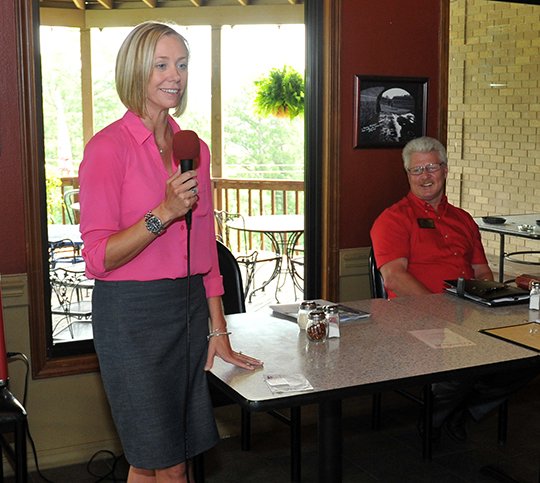HOT SPRINGS VILLAGE -- Help is on the way for Garland County voters frustrated by long lines at the polling place during last year's primary and general elections, County Clerk Sarah Smith told the Hot Springs Village TEA Party Tuesday.
The county's inclusion in a pilot program that will distribute new voting equipment to four counties before the March 1 primary elections gets to the root of the problem.
"We just don't have enough equipment," Smith told the gathering at Charlie's Pizza Pub. "Equipment was a major problem for us. That's why everybody had to wait, because we just didn't have the machines to handle it."
Smith said Garland County has more registered voters per electronic voting machine than the three other counties participating in the program. Its approximately 50 Ivotronic touch screens leave one machine for every 1,166 voters, a ratio almost five times larger than Boone County's one machine for every 256 voters.
Smith said Columbia County has one machine for every 490 voters, and Sebastian has one machine per 820 voters. The secretary of state's office said last month that it will allocate $693,710 of equipment to Garland County, a figure based on the value of the county's current stable of machines.
Last month, Garland County Election Commission Chairman Gene Haley said the county requested 30 to 35 scanners for reading and tabulating paper ballots and more than 100 touch screen voting systems.
Smith said the program includes electronic poll books that will streamline ballot distribution and prevent voters from receiving incorrect ballots, a problem some voters reported during last November's general election.
Voter information is displayed when the poll worker enters the voter's name. It includes a signature poll workers can compare to the voter sign-in sheet to verify a voter's identity. The poll book prints a slip with a bar code designating the voter's ballot style that the voter feeds into the touch screen machine.
"When you put (the slip) in the machine, it automatically populates which ballot you are supposed to receive as opposed to us having to look it up, write it down on a slip and give it to somebody," Smith told the audience. "That should remove a lot of the problems we had with that issue in the last election cycle."
Under the current system, large, unwieldy books the county clerk's office maintains contain voter information. A poll worker flips through them to find the voter's precinct and writes down the alphanumeric designation on a piece of paper. The voter gives the paper to another poll worker who uses it to cue up the appropriate ballot on the touch screen or identify which style of paper ballot to distribute.
Poll workers drop precinct slips into a box when they issue paper ballots. The number of each ballot style distributed should correspond to the amount of slips bearing that particular alphanumeric designation.
The new poll books update voter information in real time and display a color-coded message indicating if voters have already cast an absentee ballot or voted during early voting, a requirement for the vote center model the election commission is considering implementing for the primary.
Enabled by 2013 legislation, vote centers are election day polling places for voters from all county precincts, a system akin to the three locations used during early voting. The election commission proposed using eight to 10 vote centers for the primary instead of assigning voters to one of 24 polling places based on their precinct.
Real-time updates aren't required in a conventional election day setting, when voters cast ballots at a designated location. A notation entered in that location's poll book after a voter checks in indicates if they've already cast a ballot that day or during early voting.
Secretary of State Mark Martin announced last month that he had selected Omaha-based Election Systems & Software's almost $30 million proposal to continue as the state's election vendor. The Legislature appropriated $30 million for new equipment earlier this year, but the spending authority has yet to be funded.
The $2.5 million pilot program is being funded solely by the secretary of state's office.
"It's my understanding the state has placed an order for our new equipment, and we're supposed to be using that in March," Smith told the gathering.
Local on 07/08/2015